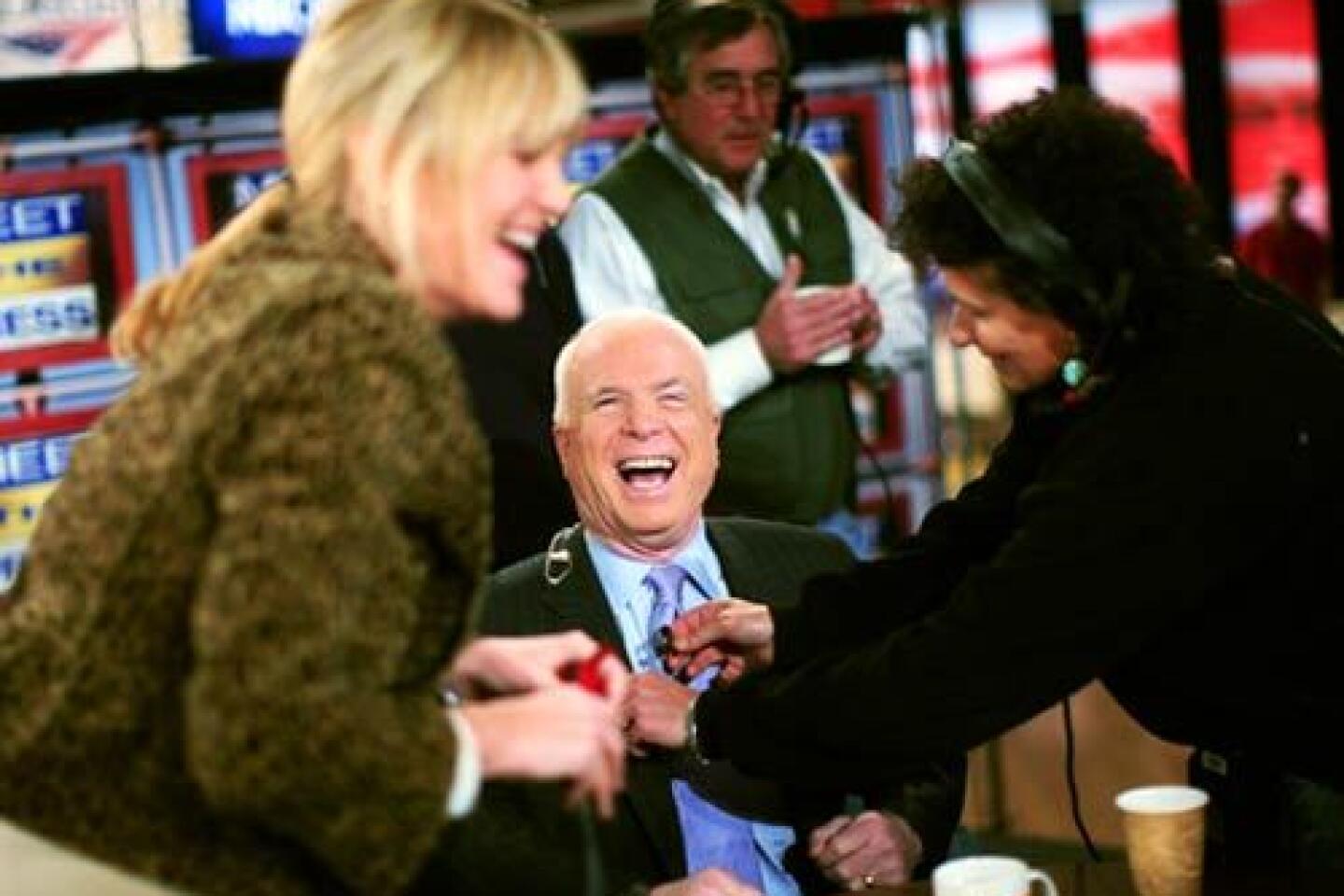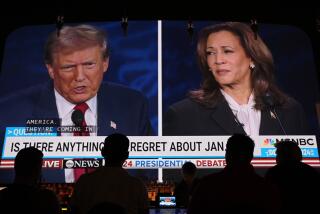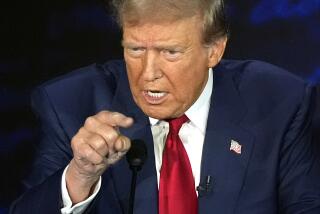The face of power
BACK in June, Sen. Hillary Rodham Clinton took the stage for a Democratic debate with a visage so flawless it started a flurry of Botox and plastic surgery rumors. In October during a Republican debate, Mitt Romney proved once again that he’ll never show up with a hair out of place and always exude an enviable degree of perfection. And earlier this month, during the most recent televised exchange among candidates, Fred Thompson, the real-life Hollywood actor who should know better, appeared with bags under his eyes so noticeable you’d think he hadn’t slept since the first season of “Law & Order.”
FOR THE RECORD:
Politicians’ debate makeup: An article in the Sunday Image section about makeup artist Kriss Soterion said that both presidential primary debates in Southern California will take place Jan. 30. Republican candidates meet Jan. 30 at the Ronald Reagan Presidential Library in Simi Valley, but Democratic candidates meet Jan. 31 at the Kodak Theatre in Hollywood. —
The 2008 election is the most profound image contest in U.S. political history. The protracted media coverage -- back-to-back debates and 24-hour TV exposure -- is certainly one reason, but so is the remarkable range of candidates separated in age by nearly 25 years, with white hair, gray hair, colored hair and no hair, and the first serious female and African American presidential contenders. With the primary races running as close as they are, the pressure to look good has never been more important.
Which makes it all the more surprising that one woman stands behind them all -- Democrats and Republicans -- helping present their faces to the American electorate, while quietly shaping the way we view those jockeying to lead the country.
Hollywood celebrities have Paul Starr as their go-to makeup guru, fashion designers have Pat McGrath -- and the political world has Kriss Soterion, a former New Hampshire beauty queen with a lower back tattoo and the distinction of having powdered the noses of every major presidential candidate for the past 16 years. She went from small-town makeup artist to master of the political face, not by playing up features or shaving off years, but by achieving the kind of no-makeup makeup that we’re accustomed to seeing on the campaign trail -- a healthy, shine-free sameness, no matter the age, race or gender.
Soterion has made up members of both parties in the last seven primary debates sponsored by CNN, and she’ll be waiting in the wings, sable brush in one hand and mineral powder foundation in the other, when the remaining Democrats take the stage in Myrtle Beach, S.C., Monday night and when candidates from both parties face off in Southern California on Jan. 30.
“Most political scientists would say image doesn’t count so much,” says Shanto Iyengar, who teaches political science and communications at Stanford and has authored several books about media and politics. “But in close contests like this one, there is a big emphasis on issues of attractiveness and appearance.”
Iyengar cites the famous 1960 Nixon-Kennedy debate at which a profusely sweating, unshaven Richard M. Nixon refused makeup and came across as untrustworthy to the TV audience (radio listeners gave him higher marks), as well as the 2000 debate between then-Vice President Al Gore and Republican presidential challenger George W. Bush during which the Gore appeared to melt in front of the cameras.
“It’s never good for a candidate when you are talking about their makeup the next day,” says Alan Schroeder, author of “Presidential Debates: Forty Years of High-Risk TV” and a professor at Northeastern University.
“The ideal is to have a high-energy, invigorating appearance, which suggests you are action-oriented, and likely to be a doer, not a talker,” Iyengar says. “You don’t want to be seen as sedentary, weak or passive.” But if you are too made up, you risk alienating the people who are inclined to vote for you and opening yourself up to criticism about superficiality.
Which is where Soterion’s famously light touch comes in.
‘A blank canvas’
“I’m probably the only person in the entire world who has had such intimate contact with every presidential candidate in the past four elections,” Soterion says, curling up on the couch of her Kriss Cosmetics salon last month in Manchester. She decamps here between freelance gigs, teaching women of the Granite State how to apply makeup and selling a namesake line of cosmetics that includes lipstick colors “Bombshell,” “Betrayal,” “Surrender” and “Sheer Chocolate Cherries.”
Soterion’s routine for preparing a male candidate begins with a camouflage concealer to cover any trouble spots, followed by a cream compact foundation. “With men, you’re just matching skin tone -- creating a blank canvas,” she says. “I know [Sen. John] McCain’s skin tone, [former New York Mayor Rudolph W.] Giuliani’s skin tone and [Sen. Barack] Obama’s skin tone so well I can grab a compact out of my kit without even looking.”
She follows with a mattifying, light-reflective mineral powder and finishes with a rice-based invisible blotting powder to combat shine. “If someone is looking a little tired or under the weather, I might add a little bronzer to give them a little glow. Then I check the eyebrows, the back of the ears and neck area, maybe give ‘em some lip balm, and they are good to go.”
For women, she starts with a retexturizing cream and then follows the camo concealer with a liquid foundation. Both have higher light-reflective properties that, she says, help create a natural glow. And that’s not the only thing that’s different. “I’m putting on eye shadow colors, eyeliner colors, blush colors and lipstick colors that not only need to flatter the skin tone but also coordinate with what they’re wearing. If she decided to wear a purple suit, red lipstick is going to clash.”
Which is why, whenever she works with Clinton, she’ll get an advance notice texted to her BlackBerry about the New York senator’s wardrobe choice. “If it’s something like ‘tweed charcoal suit,’ I’m like ‘Yes!’ because the cool palette is what looks best on her.”
Praise from Buchanan
Soterion’s first entree into the political world was in 1991 with pundit-turned-presidential candidate Pat Buchanan when he was starting his Republican primary run in New Hampshire. Soterion’s husband, Scott, struck up a conversation with Buchanan’s campaign manager -- in a men’s room, of all places -- and suddenly the makeup artist was tapped to pancake Pat for the cover of Newsweek.
“Makeup is important, no question about it,” says Buchanan. As for Soterion, “Not only did she do a very good job but we also got along famously and she ended up traveling around the state in the van with us.”
Soterion says she’s probably daubed makeup on Buchanan at least 200 times over the last two decades, making him second only to Gore, with whom she’s worked nearly 250 times, including the fateful debate that had the press describing the VP as something akin to an orange, waxy, wickless candle and had Soterion so distraught that she contemplated throwing in the wet wipes for good.
“He hired me, and I traveled with him for a whole year, and I knew his face like the back of my hand,” she said. “He got off the plane an hour before the debate, and he’d been campaigning in the Florida sun all day and looked like a lobster. I did the best job I possibly could concealing the red, but his face was radiating heat, and this was an hour-and-a-half debate with no commercial breaks, and I just stood off stage watching him get redder and redder and start to melt.”
But if Soterion had hung up her brush, she never would have gotten her shot at debate makeup redemption -- the June 3 Democratic debate at which she got her hands on Hillary Clinton.
A look for Clinton
She recalls Clinton arrived wearing a brown pantsuit. “As I was starting to do her makeup, her assistant held up a bright red lipstick. I looked at it, and my gut just said: ‘No way.’ It looked too political -- the lipstick equivalent of a red necktie. What I wanted to do was soften and feminize her look and make her someone women can totally relate to. She is already powerful, and I didn’t think she needed to have powerful makeup to get her message across.”
So Soterion mixed “French Red” lipstick with “Femme,” added a gloss called “Plush” and ended up with a plummy bronze hue she dubbed “Debate.” (It sells on her website for $15.) But it was Clinton’s dewy, youthful, wrinkle-free face that really caught people’s attention. “I must have gotten a thousand e-mails about that afterward,” Soterion says. “Everyone wanted to know how I did it, what products I used. Things were crazy.” (For the record, Soterion says she has never seen evidence that Clinton has had Botox, and her flawless face had more to do with the light-reflective powder that’s her stock in trade, along with the bright lights of the venue.)
Soterion says lighting is so crucial that she makes a point of attending technical rehearsals. “If it’s a small theater where they can’t bring the lights back and down, it’ll cause shadows. And the best makeup application in the world can’t fight shadows; dark areas sink in, the lines look deeper and everything looks more pronounced.”
Which explains former Tennessee Sen. Thompson’s Jan. 5 appearance on the stage in New Hampshire. Soterion and two assistants knew they wouldn’t be able to mask the puffy bags under Thompson’s eyes that made him look old and tired. “At that point all you can really do is hit him with the light, but if you light one guy, you light them all.”
But sometimes lighting is less important than the smallest thing, like lint (“Almost all the guys have crud on their jackets that needs taking care of”), and perhaps the most significant problem of all: redness. “There’s almost always ruddiness on their faces which can come from nerves or heat,” Soterion says. “It’s a bigger problem in the presidential and vice presidential debates. And it really shows up on high-definition television.”
Difficult as it is to imagine, as politics becomes more digitized (HD-TV) and disseminated (YouTube and Facebook), candidates will face even more scrutiny for their appearance and stylists like Soterion will play an increasingly important role in the making of the president. Perhaps today, the medium is less the message than the image, and the image -- sunburned, wrinkled or female -- is everything.
More to Read
Sign up for Essential California
The most important California stories and recommendations in your inbox every morning.
You may occasionally receive promotional content from the Los Angeles Times.












